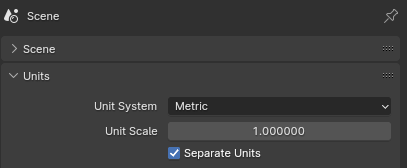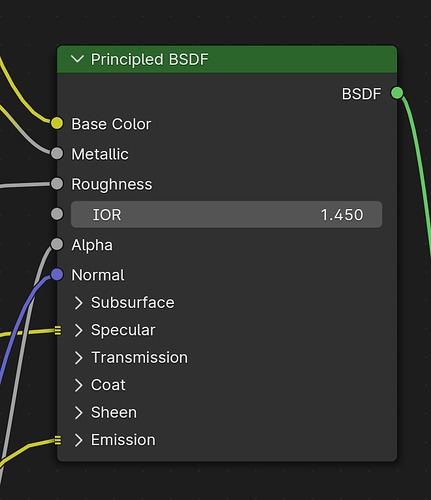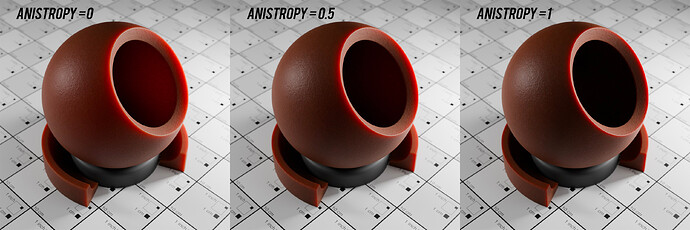PROBLEM/IMPROVEMENT 1: METALLIC
SOLUTION METALIIC OPTION 1: Isnt it also better to add metallic as a new section because metallic override transmission and subsurface like a upper layer, and also Metal rim color F0 will be added in future of principled bsdf, so isnt it better to add a new collapsable panel named metallic after subsuface and after specular because specular can be used for diffuse for all previous base layers and metallic can be like a weighted coat on all of them to create half metal materials , it gives more logical sequence when we do it. it can be called as metallic specularity
Specularity Section
-0. IOR
-1. Specular IOR LEVEL
2. specular tint
Metallic Specularity Section
- Metallic RIM F0 Tint
- Anisotrphy
- Anisotrophic Rotation
- Tangent
SOLUTION ALTERNATİVE METALLIC OPTION 2: specular section can have extra options about metallic under specular parameters, and next option can be metallic amount and the other parameter will be F0 metallic Rim color , because anisotropy is already found in specular section and its related to metallic anisotropy so metallic slider will be also put there as this: and we can add IOR to here as well maybe
- IOR
- specular ior level
- specular tint
3.metallic weight
- metallic rim color
- metallic anisotrophy
- metallic anisotrophic rotation
- Tangent
So I think we should merge metallic fully into specular section and put specular below the COAT section because it override all the other things as a FRESNEL on bases such as diffuse base, refractive base and subsurface base or trasnlucent base
PROBLEM/IMPROVEMENT 2 : LOCATION OF TRANSMISSION SECTION: Also transmision should be put after subsurface because specular layer affect the transmision and u can still change the specular tint of glass materials, so specular contains all those bases below as we know from manually making a pbr materials
Refractive base + specular (glossy with fresnel) = transmission material/glass
Diffuse base + specular = dialectric material
general base overridden by metallic specular = metal
subsurface base = subsurface material
Translucent base = translucent dialectric material
So actually transmission should be treated as base type and , specular should be treated as coat on different surface types for more logical material formation
PROBLEM 3: ALPHA SECTION. I think we should seperate ALPHA into 2 , first alpha should be a alpha mask that effects the alpha of base, for example if a base color texture has transparent/alpha parts we should add alpha mask
so that alpha should be renamed to Alpha mask and then there should be another alpha slider to artistically tweak opacity of all material , similar to how we have 2 parameter for EMİSSION section
So according the the problems I mentioned above, for better logical layering should be like this in my opinion for understanding materials:
A. BASE LAYERS & CHANGING TYPE OF BASE
0. Base Properties that affect all type of materials: (contains base color, roughness and IOR(?)
- Subsurface Base Altering (it changes the default diffuse base to subsurtface base)
- Transluceny Base Altering (not thin sheet but just like a mix shader of translucent bsdf with a weight property to make simple translucent concrete materials or artistic things, )
- Transmission base altering (it turn s base into refractice base and benefit from specular to mix with glossy to be glass, so it should not be put after specular section it should be before, and we can add thin sheet and volumetric absorbtion tint to this place as its planned for future , we might )
B. SPECULAR AND METALLIC LAYER TO ALL BASES AS MAIN COAT
- Specularity ( It will further effect tweak the ior by ior level and base that are done below, so when u change tint of specular it change the specular tint of a transmissive material so transmission section should be below specularity. I think we shuld add the IOR to this section as well to make things more logical.)
- Metallic (this can be a new section or added under specularity section to turn specular behavior to metallic specular and we can add extra featuers like METALLIC RIM color as its planned
C. EXTRA COAT LAYERS
7. Coat
8. Sheen
D. ARTISTIC TWEAK / ADDITIONAL FEATURES
9. Emission
10. Alpha/Opacity - I think we can make a new section and put ALPHA hear because it override all the layers below so its more logical and we can add a image texture socket to use a image as transparancy and then another parameter to further tweak opacity like we do in emission, so it will be easier to use without adding a node between texture and opacityyy. So it will make principled shader more versatile
So it will have alpha mask and alpha opacity as 2 parameters
I ll make a visual image to explain soon too.
EDIT: TYPO IN THE SCREENSHOT, TRANSMISSION ‘‘BEFORE’’ SPECULAR*** NOT ‘‘BELOW’’**
If we make it like this, princpled BSDF will be so robust and also logical in terms of how materials are formed (NOTE: IOR can stay in its old location if desired, it doesnt matter much, but other things are really needed to make it fully logical organization and versatile instead of being more randomly sequenced)





